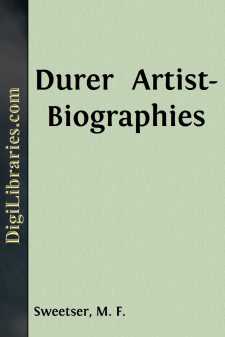Categories
- Antiques & Collectibles 13
- Architecture 36
- Art 48
- Bibles 22
- Biography & Autobiography 813
- Body, Mind & Spirit 142
- Business & Economics 28
- Children's Books 17
- Children's Fiction 14
- Computers 4
- Cooking 94
- Crafts & Hobbies 4
- Drama 346
- Education 46
- Family & Relationships 57
- Fiction 11829
- Games 19
- Gardening 17
- Health & Fitness 34
- History 1377
- House & Home 1
- Humor 147
- Juvenile Fiction 1873
- Juvenile Nonfiction 202
- Language Arts & Disciplines 88
- Law 16
- Literary Collections 686
- Literary Criticism 179
- Mathematics 13
- Medical 41
- Music 40
- Nature 179
- Non-Classifiable 1768
- Performing Arts 7
- Periodicals 1453
- Philosophy 64
- Photography 2
- Poetry 896
- Political Science 203
- Psychology 42
- Reference 154
- Religion 513
- Science 126
- Self-Help 84
- Social Science 81
- Sports & Recreation 34
- Study Aids 3
- Technology & Engineering 59
- Transportation 23
- Travel 463
- True Crime 29
Durer Artist-Biographies
by: M. F. Sweetser
Description:
Excerpt
CHAPTER I.
The Activities of Nuremberg.—The Dürer Family.—Early Years of Albert.—His Studies with Wohlgemuth.—The Wander-Jahre.
The free imperial city of Nuremberg, in the heart of Franconia, was one of the chief centres of the active life of the Middle Ages, and shared with Augsburg the great trans-continental traffic between Venice and the Levant and Northern Europe. Its municipal liberties were jealously guarded by venerable guilds and by eminent magistrates drawn from the families of the merchant-princes, forming a government somewhat similar to the Venetian Council. The profits of a commercial prosperity second only to that of the Italian ports had greatly enriched the thrifty burghers, aided by the busy manufacturing establishments which made the city “the Birmingham of the Middle Ages.” Public and private munificence exerted itself in the erection and adornment of new and splendid buildings; and the preparation of works of art and utility was stimulated on all sides. It was the era of the discovery of America, the revival of classic learning, and the growth of free thought in matters pertaining to religion. So far had the inventions of the artisans contributed to the comfort of the people, that Pope Pius II. said that “A Nuremberg citizen is better lodged than the King of Scots;” and so widely were they exported to foreign realms, that the proud proverb arose that
“Nuremberg’s hand
Goes through every land.”
Nuremberg still stands, a vast mediæval relic, in the midst of the whirl and activity of modern Germany, rich and thriving, but almost unchanged in its antique beauty. The narrow streets in which Dürer walked are flanked, as then, by quaint gable-roofed houses, timber-fronted, with mullioned windows and arching portals. In the faded and venerable palaces of the fifteenth century live the descendants of the old patrician families, cherishing the memories and archives of the past; and the stately Gothic churches are still rich in religious architecture, and in angular old Byzantine pictures and delicate German carvings. On the hill the castle rears its ponderous ramparts, which have stood for immemorial ages; and the high towers along the city walls have not yet bowed their brave crests to the spirit of the century of boulevards and railroads.
With two essentials of civilization, paper and printing-presses, Nuremberg supplied herself at an early day. The first paper-mill in Germany was established here in 1390; and its workmen were obliged to take an oath never to make paper for themselves, nor to reveal the process of manufacture. They went out on a strike when the mill was enlarged, but the authorities imprisoned them until they became docile once more. Koberger’s printing-house contained twenty-four presses, and employed over a hundred men, printing not only Bibles and breviaries, but also chronicles, homilies, poems, and scientific works. As the Aldine Press attracted many authors and scholars to Venice, so Koberger’s teeming press led several German literati to settle at Nuremberg. For the four first years of Dürer’s life, the wonderful mathematician and astronomer Regiomontanus dwelt here, and had no less than twenty-one books printed by Koberger. His numerous inventions and instruments awakened the deepest interest in the Nuremberg craftsmen, and stimulated a fruitful spirit of inquiry for many years.
The clockmakers of Nuremberg were famous for their ingenious productions. Watches were invented here in the year 1500, and were long known as “Nuremberg eggs.” The modern composition of brass was formed by Erasmus Ebner; wire-drawing machinery also was a Nuremberg device; the air-gun was invented by Hobsinger; the clarionet, by Denner; and the church-organs made here were the best in Germany....


